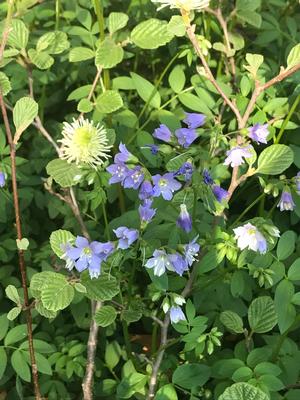New Moon Nurseries
Polemonium reptans
Jacobs ladder
Native to North America
FIRST IMPRESSIONS: Polemonium reptans is a lovely spring ephemeral wildflower that forms 12-18” tall clumps. Leaves are pinnately divided into a feather-like arrangement of 7-21 oblong leaflets. In spring the soft green foliage is crowned by loose branched clusters of bell shaped pinkish or sky blue flowers. Jacob’s Ladder is a fine groundcover for woodlands or shade gardens with moist well drained soil.
HABITAT & HARDINESS: Polemonium reptans occurs in eastern Ontario and Quebec and through most of the Eastern United States west to Minnesota, Oklahoma and Mississippi.
This species is indigenous to rich deciduous woodlands, stream and river banks, wooded slopes and bases of sandstone canyons. Plants are generally found in high quality woods shaded by deciduous trees.
Plants are hardy from USDA Zones 3-8.
PLANT DESCRIPTION: Polemonium reptans is a sprawling rhizomatous perennial groundcover. Plants have a short vertical crown and many fibrous roots.
The attractive leaves are alternately arranged on green or purplish stems. They appear to be compound but are actually pinnately divided into inch long oval or oblong segments. Each segment has a pointed tip and smooth edge. The entire leaf averages 8-9” length.
The fertile stems terminate in loose open flower corymbs. The individual florets are bell shaped and about ½” across. Each floret has 5 rounded blue-violet or pinkish petals.
Blooming occurs in late spring for 2-3 weeks. Small oval tan colored seed capsules follow.
Plants grow 12-18” tall with an equal spread. Even though plants have short rhizomes, they spread mostly by reseeding.
CULTURAL & MAINTENANCE NEEDS: Polemonium reptans flourishes in bright shade with moist rich loamy soil. Plants tolerate sandy soils, acid or alkaline pH and some sun if abundant moisture is present.
This species has little drought tolerance and will often go dormant if insufficient moisture is present.
Plants are fairly pest resistant and are not palatable to deer.
If sited in an ideal site with partial shade and moist soil, this species will often produce an abundance of seedlings.
LANDSCAPE USES: Polemonium reptans provides attractive foliage and Showy Blooms for the Woodland or Shade Garden. It is an appealing Groundcover, Grouping or Mass for a Wildlife Garden. This species is appropriate for Cottage Gardens, Pollinator Gardens, Low Maintenance Plantings, Perennial Borders and is a useful Butterfly Nectar Plant.
COMPANION & UNDERSTUDY PLANTS: Try pairing Polemonium reptans with Aquilegia canadensis, Carex albicans, Carex plantaginea, Heuchera americana 'Dales Strain', Dryopteris marginalis or Polystichum acrostichoides.
Phlox divaricata is a relative with similar flower color and culture that could be substituted in some situations.
TRIVIA: A wide variety of native bees and honeybees sip nectar from the blossoms. Flowers are also visited by butterflies, skippers and moths.
The common name refers to the pairs of opposite leaf segments that somewhat resemble the rungs of a ladder. In a Biblical story, Jacob dreamed of a ladder that connected Heaven and Earth.
Sometimes known as “abscess root” due to the historical use of the dried rhizomes to treat skin conditions, coughs, bronchitis and insect or snake bites.
Along with the many Phlox spp., this species belongs to the family Polemoniaceae commonly known as the Phlox Family or Jacob’s Ladder Family.
Height:
12-18 inSpread:
12-18 inSpacing:
24 inUSDA Hardiness Zone:
3-8Bloom Color:
BluePolemonium reptans Characteristics
Attracts Wildlife
- Pollinators
Attributes
- Rain Garden
- Naturalizing
- Favorite
- East-Coast Native
- Bog
Exposure
- Full Shade to Partial Shade
Deer Resistant
- Deer Resistant
Flowering Months
- May
Foliage Color
- Green
Juglans nigra Tolerance (Black Walnut)
- Yes
Season of Interest (Foliage)
- Summer
- Spring
Soil Moisture Preference
- Moist to Wet
Interesting Notes:
For more information on this plant, visit the USDA PLANTS Database: http://plants.usda.gov/java/profile?symbol=pore2
